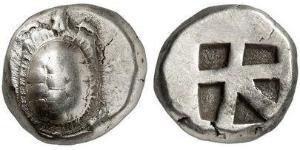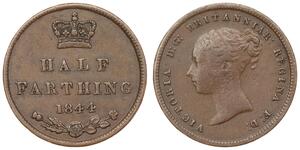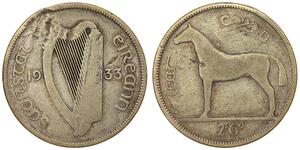[ 5187] SICILY: Himera Silver Drachm (18mm, 5.45 gm.) Sicily, Himera: c.500 B.C. Reference: SNG Copenhagen -; SNG ANS 146. Cock standing right; dotted border. Hen standing right, within incuse square. Provided with certificate of authenticity. CERTIFIED AUTHENTIC by Sergey Nechayev, PhD - Numismatic Expert Syracuse pronounced , Sicilian: Sarausa, Ancient Greek: Συράκουσαι – transliterated: Syrakousai) is a historic cityin southern Italy, the capital of the province of Syracuse. The city is famous for its rich Greek history, culture,amphitheatres, architecture and association to Archimedes, playing an important role in ancient times as one of the top powers of the Mediterranean world; it is over 2,700 years old. Syracuse is located in the south-east corner of the island of Sicily, right by the Gulf of Syracuse next to the Ionian Sea.The city was founded by Ancient Greek Corinthians and became a very powerful city-state. Syracuse was allied with Sparta and Corinth, exerting influence over the entire Magna Grecia area of which it was the most important city. Once described by Cicero as "the greatest Greek city and the most beautiful of them all", it later became part of the Roman Republic and Byzantine Empire. After this Palermo overtook it in importance, as the capital of theKingdom of Sicily. Eventually the kingdom would be united with the Kingdom of Naples to form the Two Siciliesuntil the Italian unification of 1860. In the modern day, the city is listed by UNESCO as a World Heritage Site along with the Necropolis of Pantalica. In the central area, the city itself has a population of around 125,000 people. The inhabitants are known asSiracusans, and the local language spoken by its inhabitants is the Sicilian language. Syracuse is mentioned in theBible in the Acts of the Apostles book at 28:12 as Paul stayed there.[2] The patron saint of the city is Saint Lucy; she was born in Syracuse and her feast day, Saint Lucy's Day, is celebrated on 13 December. Greek period Main articles: Magna Graecia and List of Tyrants of Syracuse Syracuse and its surrounding area have been inhabited since ancient times, as shown by the findings in the villages of Stentinello, Ognina, Plemmirio, Matrensa, Cozzo Pantano and Thapsos, which already had a relationship withMycenaean Greece. Syracuse was founded in 734 or 733 BC by Greek settlers from Corinth and Tenea, led by the oecist (colonizer)Archias, who called it Sirako, referring to a nearby salt marsh. The nucleus of the ancient city was the small island of Ortygia. The settlers found the land fertile and the native tribes to be reasonably well-disposed to their presence. The city grew and prospered, and for some time stood as the most powerful Greek city anywhere in theMediterranean. Colonies were founded at Akrai (664 BC), Kasmenai (643 BC), Akrillai (VII century BC),Helorus (VII century BC) and Kamarina (598 BC). The descendants of the first colonist, called Gamoroi, held the power until they were expelled by the Killichiroi, the lower class of the city. The former, however, returned to power in 485 BC, thanks to the help of Gelo, ruler of Gela. Gelo himself became the despot of the city, and moved many inhabitants of Gela, Kamarina and Megera to Syracuse, building the new quarters of Tyche and Neapolisoutside the walls. His program of new constructions included a new theater, designed by Damocopos, which gave the city a flourishing cultural life: this in turn attracted personalities as Aeschylus, Ario of Metimma, Eumelos ofCorinth and Sappho, who had been exiled here from Mytilene. The enlarged power of Syracuse made unavoidable the clash against the Carthaginians, who ruled western Sicily. In the Battle of Himera, Gelo, who had allied with Theron of Agrigento, decisively defeated the African force led by Hamilcar. A temple, entitled to Athena (on the site of the today's Cathedral), was erected in the city to commemorate the event Gelon was succedeed by his bro ...
más ...
Similar Coin Groups

4 Obol / 1 Tetrobol Antigua Grecia (1100 ...
grupo tiene 12 monedas / 6 precios
Add coin to this group

1 Denario Imperio romano (27BC-395) Plat ...
grupo tiene 2 monedas / 1 precios
Add coin to this group

10 Mark República Democrática Alemana (1 ...
grupo tiene 9 monedas / 9 precios
Add coin to this group
2025-06-14
- New coin is added to 1/2 Farthing Reino Unido de Gran Bretaña e Irlanda (1801-192 ...
1/2 Farthing Reino Unido de Gran Bretaña e Irlanda (1801-192 ...
grupo tiene 9 monedas / 8 precios
⇑
Great Britain - 1/2 Farthing 1844 - Victoria
2025-06-14
- New coin is added to 1/2 Crown Irlanda (1922 - )
1/2 Crown Irlanda (1922 - )
grupo tiene 44 monedas / 43 precios
⇑
Ireland - 1/2 Crown / 2 Shillings 6 Pence 1933 - Horse , Silver
Usted podría estar interesado en …












-300-150-YYnBwcI0woEAAAEnE4RaOLOG.jpg)

-300-150-cqgKbzbiQeMAAAFLYpCjltiK.jpg)






